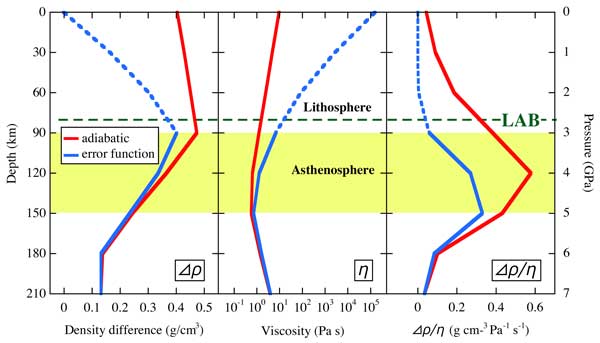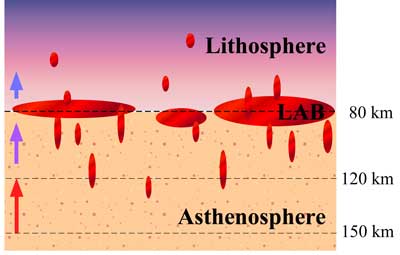 |
Ponded melt at the boundary between the lithosphere and asthenosphere |
Tatsuya Sakamaki1, Akio Suzuki1,
Eiji Ohtani1, Hidenori Terasaki2, Satoru Urakawa3, Yoshinori Katayama4, Ken-ichi Funakoshi5, Yanbin Wang6, John W. Hernlund7, Maxim D. Ballmer8
1Department of Earth and Planetary Materials Science, Tohoku University, Sendai 980-8578, Japan; sakamaki@m.tohoku.ac.jp ; a-suzuki@m.tohoku.ac.jp ; ohtani@m.tohoku.ac.jp
2Department of Earth and Space Science, Osaka University, Osaka 560-0043, Japan; terasaki@ess.sci.osaka-u.ac.jp
3Department of Earth Sciences, Okayama University, Okayama 700-8530, Japan; urakawa@cc.okayama-u.ac.jp
4Japan Atomic Energy Agency, Hyogo 679-5143, Japan; katayama@spring8.or.jp
5Spring-8, Japan Synchrotron Radiation Institute, Hyogo 679-5148, Japan; funakosi@spring8.or.jp
6Center for Advanced Radiation Sources, The University of Chicago, Chicago, Illinois 60637, U.S.A; wang@cars.uchicago.edu.
7Department of Earth and Planetary Science, University of California, Berkeley 94720, U.S.A.; hernlund@gmail.com
8Department of Geology and Geophysics, School of Ocean and Earth Sciences and Technology, University of Hawaii at Manoa, Honolulu, Hawaii 96822, U.S.A.; ballmer@hawaii.edu
This webpage is a summary of: Sakamaki, Tatsuya, Akio Suzuki, Eiji Ohtani, Hidenori Terasaki, Satoru Urakawa, Yoshinori Katayama, Ken-ichi Funakoshi, Yanbin Wang, John W. Hernlund & Maxim D. Ballmer, Ponded melt at the boundary between the lithosphere and asthenosphere, Nature Geoscience, 6, 1041 - 1044, 2013.
The lithosphere-asthenosphere boundary is one of the two unusual physical discontinuities in the Earth’s interior (Gutenberg, 1926) across which seismic velocities decrease and attenuation increases. It has long been suggested that existence of partial melt is responsible for the low-velocity and high attenuation characteristics of the asthenosphere (Schmerr, 2012). Stagnation and ponding of melt can be controlled by melt migration rates in the deep Earth. Density and viscosity of basaltic magmas, intimately linked to the atomic structure, dominate the process of melt separation from the surrounding rocks. We used X-ray absorption for in-situ density determination of basaltic magma under pressures. We applied in-situ falling-sphere viscometry and in-situ X-ray diffraction to measure magma viscosity and magma structure, respectively. The resulting complete and detailed dataset allowed us to examine pressure-dependent changes of magma density, viscosity and structure in unprecedented detail.
Gravity-driven separation of buoyant magma from partially molten rock is proportional to the “hydrostatic magma mobility” (defined as Δρ/η) in addition to the permeability (Connolly et al., 2009). Here, η is melt viscosity, and Δρ is the density difference between the magma and the surrounding solid rock. Figure 1a shows that, for any plausible choice of geotherm, Δρ decreases rapidly from 100 to 180 km depth (i.e., ~3.5 to ~6 GPa). This transition is caused by a coordination change of Al in the melt with an unusually large compressibility almost five times higher than usual above and below this depth range. Also, Δρ slightly decreases from ~100 km depth to the surface (Figure 1a). This slight decrease of Δρ is a conservative estimate as we do not consider the effects of successive removal of garnet and clinopyroxene, as well as of an increase of Mg# (in olivine) in the residual MOR melting column (i.e., the oceanic lithosphere). The resulting maximum in Δρ at 3-4 GPa, in combination with a minimum in η at 4-5 GPa (Figure 1b), results in a peak in magma mobility at ~120-150 km depth in the Earth’s mantle (Figure 1c).

Figure 1: Magma properties and mobility as a function of depth. (a) Density difference between basaltic magma and olivine (Δρ) as a function of depth (and pressure). The red and blue lines are based on an adiabatic temperature gradient, and a realistic error-function temperature profile for mature oceanic lithosphere, respectively. The potential temperature is 1623 K. Yellow shading highlights the depth range with anomalous physical properties of basaltic melts due to the structural transition in Al coordination. (b) Viscosity (η) of basaltic magma along the same two profiles. Hypothetical subsolidus density and viscosity profiles are dashed. (c) Mobility Δρ/η of basaltic magma along the same two profiles, respectively.
The peak in melt mobility at ~120-150 km depth carries important implications for the nature of Earth’s shallow mantle. The decreased mobility of melt as magma ascends from a partially molten asthenosphere gives rise to a tendency for excess melt accumulation at 80-100 km depth (Figure 2). Unless vertical dikes or channels form in the lithosphere that would otherwise allow the melts to escape (Spiegeman, 1993), magma generated at depth would accumulate atop the asthenosphere. Indeed, a recent magnetotelluric study suggests such a scenario beneath the edge of the Cocos plate (Naif et al., 2013). Excessive melt accumulation at these depths may also lead to rheological weakening, enhanced shear deformation, and formation of sub-horizontal melt bands that would further decrease vertical melt mobility (Bruhn et al., 2000). However, this excess magma may also be cooled by heat conduction to the overlying lithosphere, which would cause it to freeze, further restricting permeability and possibly giving rise to the formation of an extensive network of basaltic sills at the base of the lithosphere. Excess melt accumulation at 80-100 km depth may help explain the origin of the seismically observed Gutenberg discontinuity (Gutenberg, 1926), as well as its geographical correlation with features suggestive of recent partial melting of the mantle (Schmerr, 2012).

Figure 2: Schematic illustration of the lithosphere and asthenosphere boundary (LAB). Magma mobility is faster between 120 km and 150 km, causing relative magma depletion. The LAB at around 80 km depth can be a zone of excessive melt accumulation, since it can be fluxed at higher rates from below where mobility is higher, but is removed at much slower rate above where mobility is lower.
References
-
Bruhn, D., Groebner, N. & Kohlstedt, D. L. An interconnected network of core–forming melts produced by shear deformation. Nature 403, 883–886 (2000).
-
Connolly, J. A. D., Schmidt, M. W., Solferino, G. & Bagdassarov, N. Permeability of asthenospheric mantle and melt extraction rates at mid–ocean ridges. Nature 462, 209–212 (2009).
-
Gutenberg, B., Untersuchungen zur Frage, bis zu welcher Tiefe die Erde kristallin ist. Z. Geophysik 2, 24-29 (1926).
-
Naif, S., Key, K., Constable, S. & Evans, R. L. Melt-rich channel observed at the lithosphere-asthenosphere boundary. Nature 495, 356-359 (2013).
-
Schmerr, N., The Gutenberg Discontinuity: Melt at the Lithosphere-Asthenosphere Boundary. Science 335, 1480-1483 (2012).
-
Spiegelman M. Physics of melt extraction: theory, implications and applications. Phil. Trans. R. Soc. Lond. A 342, 23–41 (1993).
last updated 4th
February, 2014 |
